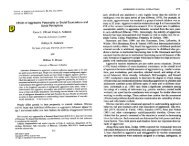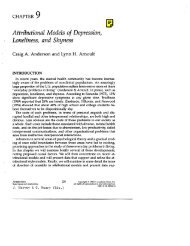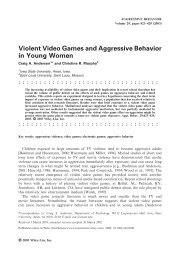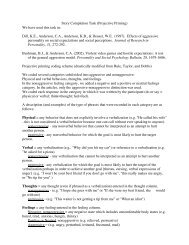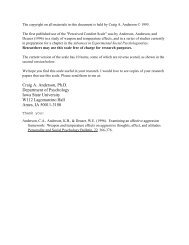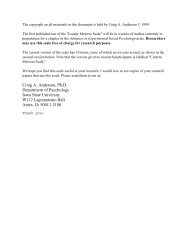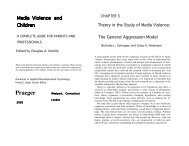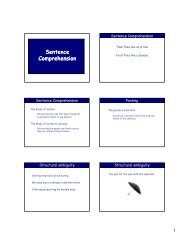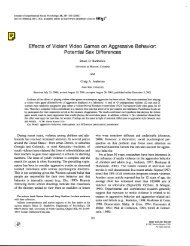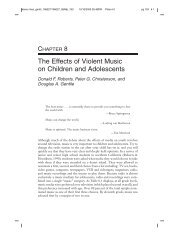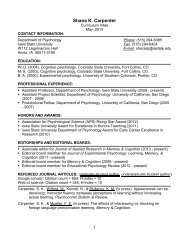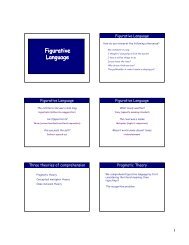Holland's RIASEC Model as an Integrative Framework for Individual ...
Holland's RIASEC Model as an Integrative Framework for Individual ...
Holland's RIASEC Model as an Integrative Framework for Individual ...
You also want an ePaper? Increase the reach of your titles
YUMPU automatically turns print PDFs into web optimized ePapers that Google loves.
INTEGRATING INDIVIDUAL DIFFERENCES<br />
3<br />
Con<strong>for</strong>mity<br />
Data<br />
C<br />
E<br />
Things<br />
R<br />
I<br />
A<br />
Ide<strong>as</strong><br />
m<strong>an</strong>, & Heggestad, 1996; Lowm<strong>an</strong>, Williams, & Leem<strong>an</strong>, 1985;<br />
R<strong>an</strong>dahl, 1991; Rolfhus & Ackerm<strong>an</strong>, 1996). The results of these<br />
studies support a number of <strong>as</strong>sociations between <strong>RIASEC</strong>-b<strong>as</strong>ed<br />
interest me<strong>as</strong>ures <strong>an</strong>d ability me<strong>as</strong>ures, including math, spatial,<br />
<strong>an</strong>d mech<strong>an</strong>ical abilities linked with the I <strong>an</strong>d R types; verbal <strong>an</strong>d<br />
literary with the A type; <strong>an</strong>d perceptual speed <strong>an</strong>d numerical<br />
computation with the C type. Negative correlations have also been<br />
found between the E type <strong>an</strong>d most ability me<strong>as</strong>ures, <strong>an</strong>d between<br />
the S type <strong>an</strong>d math/spatial abilities.<br />
Sociability<br />
People<br />
Figure 1. Holl<strong>an</strong>d’s hexagon, a circumplex model of interest structure<br />
with dimensions proposed by Hog<strong>an</strong> (1983) <strong>an</strong>d Prediger (1982).<br />
circumplex (Hog<strong>an</strong>, 1983; Rounds, Tracey, & Hubert, 1992).<br />
Research h<strong>as</strong> generally supported the circular ordering of the six<br />
<strong>RIASEC</strong> interest types <strong>an</strong>d work environments in the United States<br />
(Rounds & Tracey, 1993; Tracey & Rounds, 1992). There<strong>for</strong>e,<br />
Holl<strong>an</strong>d’s taxonomy of interest types <strong>an</strong>d parallel environments<br />
provide a set of empirically validated reference points <strong>for</strong> representing<br />
the circumplex structure of interests.<br />
Personality, Interests, <strong>an</strong>d Abilities<br />
Holl<strong>an</strong>d stated that personality types <strong>an</strong>d interest types are<br />
functionally equivalent (Holl<strong>an</strong>d, 1997, 1999), but personality <strong>an</strong>d<br />
interests are generally considered to be distinct psychological<br />
constructs, albeit with some notable connections (Hog<strong>an</strong> & Blake,<br />
1999; Savick<strong>as</strong>, 1999). In the area of personality research, the<br />
five-factor model (i.e., Openness to Experience, Conscientiousness,<br />
Extroversion, Agreeableness, <strong>an</strong>d Neuroticism) h<strong>as</strong> emerged<br />
<strong>as</strong> a domin<strong>an</strong>t org<strong>an</strong>izational framework <strong>for</strong> personality traits<br />
(Digm<strong>an</strong>, 1990) <strong>an</strong>d h<strong>as</strong> become the focus of research linking<br />
personality with Holl<strong>an</strong>d’s interest types. Recent meta-<strong>an</strong>alyses<br />
(Barrick et al., 2003; Larson et al., 2002) have demonstrated<br />
relations between <strong>RIASEC</strong> interests <strong>an</strong>d the five-factor model of<br />
personality (Costa & McCrae, 1992) that are consistent with Holl<strong>an</strong>d’s<br />
conceptualization of his interest types. The two strongest<br />
<strong>as</strong>sociations between <strong>RIASEC</strong> <strong>an</strong>d the five-factor model are between<br />
Extroversion <strong>an</strong>d the S <strong>an</strong>d E types, <strong>an</strong>d between Openness<br />
to Experience <strong>an</strong>d the A <strong>an</strong>d I types (Ackerm<strong>an</strong> & Heggestad,<br />
1997; Hog<strong>an</strong> & Blake, 1999; Tokar, Fisher, & Subich, 1998).<br />
These <strong>as</strong>sociations have been found in college students (Tokar,<br />
Vaux, & Sw<strong>an</strong>son, 1995), employed adults (Costa, McCrae, &<br />
Holl<strong>an</strong>d, 1984), <strong>an</strong>d military trainees (G. D. Gottfredson, Jones, &<br />
Holl<strong>an</strong>d, 1993). Other <strong>RIASEC</strong>–five-factor <strong>as</strong>sociations have been<br />
identified between Agreeableness <strong>an</strong>d the S type (Tokar et al.,<br />
1998) <strong>an</strong>d Conscientiousness <strong>an</strong>d the C type (G. D. Gottfredson et<br />
al., 1993). A negative correlation h<strong>as</strong> been found between Neuroticism<br />
<strong>an</strong>d the E type (De Fruyt & Mervielde, 1997).<br />
Correlation-b<strong>as</strong>ed research examining relations between<br />
<strong>RIASEC</strong> interests <strong>an</strong>d me<strong>as</strong>ures of ability <strong>an</strong>d intelligence have<br />
also produced results consistent with Holl<strong>an</strong>d’s model. Ackerm<strong>an</strong><br />
<strong>an</strong>d Heggestad (1997) provided a concise summary of studies in<br />
this area (i.e., Ackerm<strong>an</strong>, K<strong>an</strong>fer, & Goff, 1995; K<strong>an</strong>fer, Acker-<br />
S<br />
Two- <strong>an</strong>d Three-Dimensional Interest Structures<br />
An import<strong>an</strong>t limitation of research linking personality <strong>an</strong>d<br />
abilities to the <strong>RIASEC</strong> types is that the focus in most studies h<strong>as</strong><br />
been on linear bivariate relationships. This methodology fails to<br />
capture the multidimensional nature of interest structure <strong>an</strong>d may<br />
not effectively represent the interrelations between individualdifferences<br />
domains. Results suggesting that E types are extraverted,<br />
A types are more open to new experiences, <strong>an</strong>d so <strong>for</strong>th,<br />
may identify the strongest relationship between a <strong>RIASEC</strong> type<br />
<strong>an</strong>d <strong>an</strong>other me<strong>as</strong>ure, but they ignore the underlying structure of<br />
the Holl<strong>an</strong>d model. An <strong>an</strong>alysis that explicitly tests Holl<strong>an</strong>d’s<br />
structural model by accounting <strong>for</strong> the interrelations among the<br />
<strong>RIASEC</strong> types would produce a more nu<strong>an</strong>ced <strong>an</strong>d complete<br />
picture of the interrelations among individual-differences constructs<br />
in the context of work environments. <strong>Model</strong>ing the relative<br />
strength of <strong>as</strong>sociations in a circumplex or other structure makes it<br />
possible to identify robust <strong>an</strong>d me<strong>an</strong>ingful relations between distinct<br />
sets of individual differences variables that are only moderately<br />
correlated.<br />
A frequently used method <strong>for</strong> representing a circumplex model<br />
is <strong>an</strong> orthogonal two-dimensional structure with coordinates that<br />
specify the relative positions of each type. For this re<strong>as</strong>on, the<br />
<strong>RIASEC</strong> interest circumplex is often referred to <strong>as</strong> a twodimensional<br />
model, <strong>an</strong>d attempts have been made to attach psychologically<br />
me<strong>an</strong>ingful labels to the dimensions. As illustrated in<br />
Figure 1, the most well-known dimensional interpretation is Prediger’s<br />
(1982) model of Data–Ide<strong>as</strong> (contr<strong>as</strong>ting E–C with I–A)<br />
<strong>an</strong>d People–Things (contr<strong>as</strong>ting S with R). Hog<strong>an</strong> (1983) proposed<br />
<strong>an</strong> alternative interpretation with a sociability dimension (contr<strong>as</strong>ting<br />
S–E with R–I) <strong>an</strong>d a con<strong>for</strong>mity dimension (contr<strong>as</strong>ting C with<br />
A). G. D. Gottfredson <strong>an</strong>d Holl<strong>an</strong>d (1996) proposed a third dimension<br />
of Cognitive or Subst<strong>an</strong>tive Complexity to add to the twodimensional<br />
interest circumplex. This dimension w<strong>as</strong> identified in<br />
a factor <strong>an</strong>alysis of the job <strong>an</strong>alysis ratings of occupational characteristics<br />
found in the fourth edition of the Dictionary of Occupational<br />
Titles (DOT; U.S. Department of Labor, 1991). The<br />
cognitive complexity dimension is orthogonal to the two <strong>RIASEC</strong><br />
interest dimensions: <strong>Individual</strong>s <strong>an</strong>d environments may vary in<br />
cognitive abilities <strong>an</strong>d dem<strong>an</strong>ds, but the interrelations between<br />
interest types do not vary <strong>as</strong> a function of the level of cognitive<br />
complexity required <strong>for</strong> <strong>an</strong> occupation (Rounds & Day, 1999). In<br />
comparison to the two-dimensional <strong>RIASEC</strong> model, there have<br />
been few investigations of this proposed three-dimensional structure.<br />
For the present article, we developed a three-dimensional<br />
interest-b<strong>as</strong>ed structure to compare with the <strong>RIASEC</strong> circumplex<br />
<strong>an</strong>d conducted a limited number of <strong>an</strong>alyses to evaluate its integrative<br />
potential.



